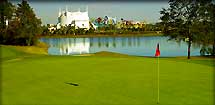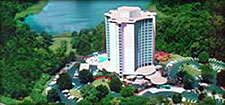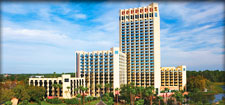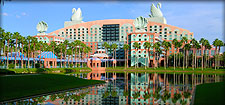|
|
MESA, Arizona – In the 11th annual Golfweek's Best Courses, the editors of Golfweek magazine named Longbow Golf Club to its list of "2009 Golfweek's Best Resort Courses."
"We are thrilled and honored to receive recognition from Golfweek," said Jay Larscheid, General Manager. "I think we all knew that Longbow would garner accolades such as this, and it's truly gratifying to have agreement from one of the golf world's most influential publications. We've simply stayed focused on our pledge to our guests to provide the highest standards in terms of service and playing conditions. It's obvious that this formula has paid off."
Longbow was ranked 89 out of 100, which, at first glance may seem a bit dubious. However, when one considers the caliber of golf clubs placed further up the list – Pebble Beach, Pinehurst, Whistling Straits, to name a few – it's clear that Longbow has earned a place among golf's elite resort courses.
Longbow Business Park and Golf Club is a 330-acre, mixed-use development, being developed by Daedalus Real Estate Advisors, that incorporates office, light industrial, retail and hotel uses surrounded by desert vegetation and a main street transportation design and features the award-winning Longbow Golf Club. Daedalus is a Phoenix-based commercial real estate services company that provides investment, development and communications consulting to corporate real estate clients. To learn more about Longbow Golf Club or to book a tee time call 480.807.5400 or visit www.longbowgolf.com.
Longbow Golf Club is professionally managed by OB Sports Golf Management, a diversified, golf-oriented company with a long history of success. OB Sports currently manages 31 premier golf courses and country clubs throughout the United States. Known for its comprehensive and personalized services since 1972, OB Sports has become widely acclaimed as the leader in boutique-style golf course management. For more information about OB Sports Golf Management visit www.obsports.com.
Experience the natural beauty of the Florida woodlands at Disney's Palm Golf Course. This majestic course is both a pleasure to play, as well as an exciting test of skill. Golfers will appreciate the course design, which features shimmering lakes and tropical sands, all across a golf landscape that's dotted with strategically placed palm trees.
Elevated greens, 9 water holes, 94 bunkers plus a fair sprinkling of water and woods make this course distinctive. As you play, you may encounter deer and other wildlife. The course provides plenty of challenges for novice players and seasoned pros alike. Disney's Palm Golf Course has received an excellent rating of 4 stars by Golf Digest.
The Verdict: The Palm course fills an interesting niche among the four golf courses at Disney World. It's a PGA Tour-caliber golf course, but perhaps a bit less so than the next-door Magnolia. The Palm is a little more secluded and picturesque than the Magnolia, but not to the extent of Tom Fazio's Osprey Ridge course. And for higher handicappers, the Palm is shorter and easier than the aforementioned pair, but not as friendly as Disney's Lake Buena Vista course.


WHERE YOU'LL PLAY
Four rounds

WHERE YOU'LL PLAY
Four rounds

WHERE YOU'LL PLAY
Four rounds
Course Opened:
1971
Course Type/Style:
Resort/Parkland
Number of Tee Boxes:
4 sets
Total Number of Sand Bunkers:
95
Number of Water Hazards:
9 of 18 holes
Most Challenging Hole: No. 14
Most Memorable Hole: No. 18
Considered one of the most difficult holes on the PGA Tour with plenty of length and a green protected by sand and water. A menacing approach shot awaits as you stand in the fairway on the finishing hole.
Sinature Hole: No. 16
The climactic 16th, a show-stopping par 3 from an elevated tee, plays entirely over water.
Acreage of Course:
90 acres
Average Size of Greens:
6,850 sq. ft.
Primary Grasses
Fairways:
Bermudagrass
Rough:
Bermudagrass
Greens:
Bermudagrass
Months Open:
January – December
High Season:
January – April
Aerification:
Overseeding:
Rounds per year:
55,000
Green Fees:
Low: $69 High: $125
Walking Options:
Mandatory Cart
Nearest airport:
Orlando International Airport
Director of Golf:
Mark Dukes, PGA
Superintendent:
Scott Welder, GCSAA
Scott Welder is the first, and only, golf course superintendent at Walt Disney World Golf Resort, having begun his career at the course in 1971 when the facility was built.
What do you need to know about TPC-Myrtle Beach, beyond the need to bring your 'A' game? Here are five tidbits that might enhance your enjoyment of the South Strand layout.
Hit it high – Generally speaking, the greens at TPC are elevated and well bunkered, so you aren't going to have much success trying to run the ball up. Make sure you iron game is sharp and be prepared to fly numerous bunkers on your way to the green.
Tournament Tested – TPC is one of Myrtle Beach golf's biggest challenges and it has the resume to prove it. The course has hosted the PGA Senior Tour Championship, the finals of the Golf.com World Amateur Handicap Championship, and every spring it hosts the General Hackler Invitational, one of the nation's best collegiate tournaments. Take the time to check out the clubhouse memorabilia.
One of a Kind – In recent years Myrtle Beach golf courses have collected honors like a kid receiving candy on Halloween, but TPC is the only course in the area to earn 5-stars in Golf Digest's prestigious "Best Places to Play" guide and one of fewer than 25 layouts in the nation to earn the distinction.
Yes, that is Dustin Johnson – Rising PGA Tour star Dustin Johnson calls TPC-Myrtle Beach home. In addition to practicing and playing at TPC, the three-time winner on tour has been known to hang around the clubhouse. Don't be shocked if you see him, but he's just one of the guys in Murrells Inlet.
That's a wild turkey, not a drink – TPC-Myrtle Beach is built on 369 acres, much of it wetlands, which means the course has plenty of breathing room and there is ample wildlife. Wild turkey roost in the swamp to the left of ninth tee and there are an abundance of deer, alligators and fox, among many other animals. Enjoy the scenery.
By Chris King on May 4, 2010
The TPC-Myrtle Beach is one of the Grand Strand's bluebloods.
It enjoys the benefit of a premium brand, superior design (the team of Lanny Wadkins and Tom Fazio is tough to beat), and it's the home course of Dustin Johnson, a three-time winner on the PGA Tour. Throw in a bevy of national honors, and it's not hard to see why the facility is so highly regarded.
Identifying the three best holes on a course that has hosted what was then the Senior PGA Tour Championship and gets a regular workout from Johnson is a challenging task, because the candidates are plentiful. We asked course owner Chip Smith to identify the best of the best at TPC-Myrtle Beach and he complied, with an assist from Johnson.
The three best holes at TPC are:
No. 5, 158-yard, Par 3: Despite being TPC's shortest hole, the fifth is one of its most challenging, particularly from the tips where the tee shot requires a long forced carry over water. The green is wider than it is deep, so your margin for error is limited. A bunker in the right front looms for players not playing from the tips, as does a bunker in back of the green.
"There is almost a false front on the front of the green," Smith said. "It's a tough little shot because the green is narrow. The right side of the green is always better than short because of the lake."
No. 17, 193-yard, par 3: The words island green and TPC have almost become synonymous because of the famed 17th at Sawgrass, and No. 17 at TPC-Myrtle Beach is a reasonable approximation. The primary differences? The 17th in Myrtle Beach is a peninsula green surrounded by water on "only" three sides and it's approximately 50 yards longer. The 17th is TPC-Myrtle Beach's signature hole and with an almost constant wind, it represents a significant challenge. "Because of the distance, I think it's a little tougher than 17 at Sawgrass," Smith says. "Now I've never stood on 17 at Sawgrass on Sunday with $1.4 million on the line either (laugh)."
No. 18, 538-yard, par 5: The 18th, with a creek running along the right side of the fairway and a large lake on the left, is Johnson's choice as the course's best. It's a classic risk-reward hole. Players that can snuggle up to the creek before it runs out to the lake can get home in two, but there is considerable risk. Half of the green is exposed to water and with the rough surrounding it shaved, it's not an easy green to hold. One person who doesn't have to worry about length is Johnson. What does one of the PGA Tour's longest hitters use to reach the green on his second shot? "Depending on which way the wind is blowing, anywhere from a 5 or 6 iron to a 3-wood," he said. For the mere mortals among us, an iron on the second shot when attempting to reach the 18th green is out of the question!